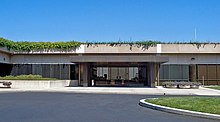Xerox PARC
The Xerox Palo Alto Research Center ( Xerox PARC ) was founded in 1970 at the suggestion of Xerox chief scientist Jack Goldman in Palo Alto , California . The company is part of the Xerox group.
Xerox lost its patent protection for xerography (photocopier) in the early 1970s and feared losing market share to Japanese manufacturers. To counteract this, PARC should develop new technologies for Xerox so that the company can continue to maintain its dominant position in the area of office technology. In the course of the 1970s, several groundbreaking technologies such as Ethernet network technology and the concept of the graphical user interface (GUI) with mouse operation were developed there, which became standards in information technology . Except for the laser printer , however, Xerox has not succeeded in any of these itself. Instead, for example, the Ethernet inventor Robert Metcalfe successfully founded his own company 3Com , and Steve Jobs brought the GUI concept he snapped up during a visit to PARC to success at Apple .
history
At the time of inception, George Pake was named executive director. If PARC is spoken of in the context of computer science, then the Computer Science Laboratory is usually meant, which however only formed part of PARC. This laboratory was originally officially headed by Jerome I. Elkind , but was secretly led by Robert W. Taylor , who was previously involved in the ARPANET project at DARPA .
Many achievements of modern computer technology can be traced back to PARC: Here the first laser printer was developed, VLSI was made possible using new design methods, Ethernet was invented, our own series of Lisp machines designed, SuperPaint developed the first computer-aided graphic image processing, the Smalltalk programming language as a model for many modern ones object-oriented programming languages developed, the concept of the laptop developed ( Alan Kays Dynabook ), the first graphical user interface developed and used for the first time in the Xerox Alto computer, the WYSIWYG model ( What you see is what you get ) set up as the basic principle for the GUI and implemented and the forerunner of PostScript developed.
With the exception of the laser printer, which was successfully marketed by Xerox in the form of the laser copier, Xerox has failed to successfully bring these inventions to market. The Xerox management was so fixated on photocopiers that it did not recognize the potential of the developments. With the Xerox Star an unsuccessful attempt was made to bring a graphic word processing system onto the market.
The success was reserved for other companies, on the one hand Apple and Microsoft , who brought operating systems with a graphical user interface onto the market, and on the other hand a large number of graduates from PARC themselves, who founded their own companies to market their inventions. The most prominent examples are likely to be Robert Metcalfe , who founded 3Com to be able to market Ethernet, and John Warnock , who left PARC to found Adobe and hence to market his invention Interpress under the name PostScript.
In fact, competitors were even allowed into the development departments. Among them were Steve Jobs and Bill Gates , who were able to take a look at the Xerox Alto and use the knowledge gained there for their own products. Years later, Jobs complained that Microsoft stole the concept of the GUI from Apple, to which Bill Gates replied:
“Well, Steve, I think there's more than one way of looking at it. I think it's more like we both had this rich neighbor named Xerox and I broke into his house to steal the TV set and found out that you had already stolen it. "
“Well, Steve, I think you can see it differently. I think it was more that we both had this rich neighbor named Xerox who I broke in to steal the TV and found that you had already stolen it. "
Nowadays PARC is also an incubator for startups like SolFocus (concentrator solar cells ) or cooperates with Powerset , a search engine that understands relationships in natural language.
Known former employees
Mark Weiser , who coined the term ubiquitous computing , was a senior scientist at the Xerox Palo Alto Research Center. Other well-known researchers at Xerox PARC were Lynn Conway (VLSI), Adele Goldberg (Smalltalk), Neil J. Gunther ( PARCbench ), Daniel P. Huttenlocher ( JBIG2 ), Butler Lampson (Alto, laser printer, Ethernet, Bravo , Mesa ), Calvin Quate , Eric Schmidt , Charles Simonyi (Bravo) and Charles P. Thacker (Alto, Ethernet, laser printer). As part of student programs, u. a. Andreas von Bechtolsheim , John Haugeland , Dana Scott and Niklaus Wirth Xerox PARC.
literature
- Douglas K. Smith, Robert C. Alexander: The Billions Game. Xerox's Battle for the First PC , Econ-Verlag, 1989, ISBN 3-430-18547-5
- Michael Hiltzik: Dealers of Lightning - XEROX PARC and the Dawn of the Computer Age , Harper Business, 1999, ISBN 0-88730-891-0
- Michael Friedewald: The computer as a tool and medium: The intellectual and technical roots of the personal computer , GNT-Verlag, 1999, ISBN 3-928186-47-7
Web links
- Official website (English)
- Think Tank Xerox Parc: The Real PC Inventors
- Screenshot of the star desktop
Individual evidence
- ↑ https://www.parc.com/about/
- ^ Andy Hertzfeld : A Rich Neighbor Named Xerox. Steve confronts Bill Gates about copying the Mac. November 1983, accessed January 20, 2015 .
Coordinates: 37 ° 24 '9.6 " N , 122 ° 8' 53.5" W.

